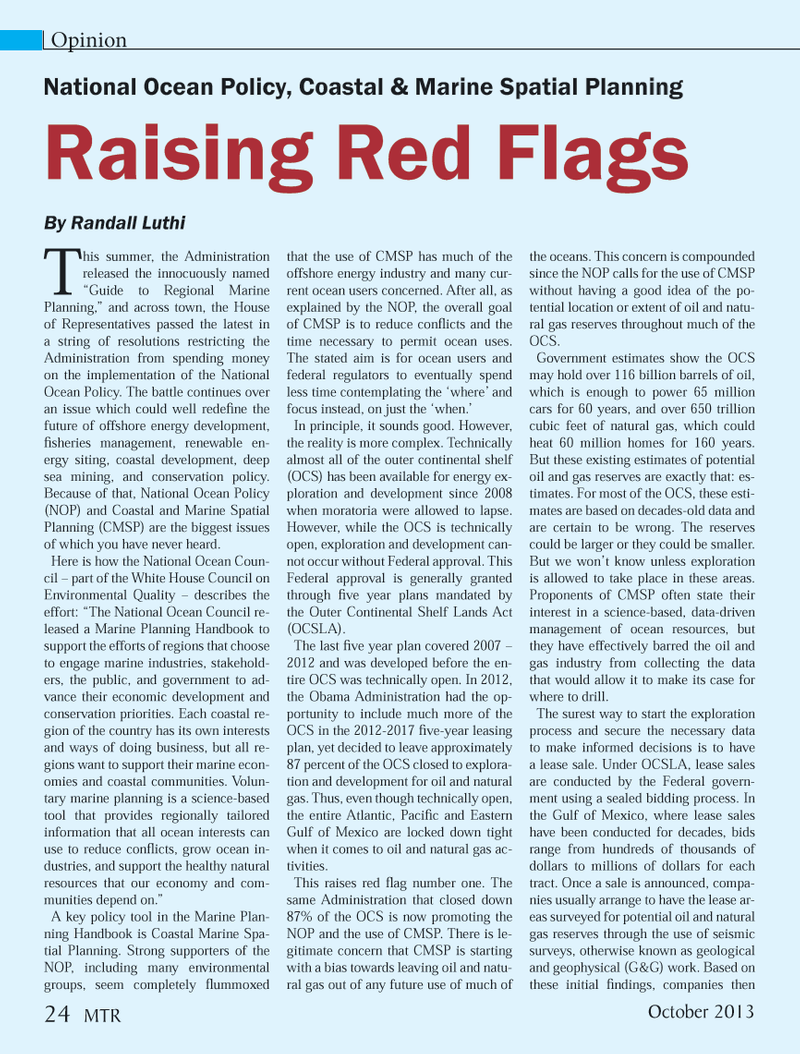
Page 24: of Marine Technology Magazine (October 2013)
Subsea Defense
Read this page in Pdf, Flash or Html5 edition of October 2013 Marine Technology Magazine
This summer, the Administration released the innocuously named ?Guide to Regional Marine Planning,? and across town, the House of Representatives passed the latest in a string of resolutions restricting the Administration from spending money on the implementation of the National Ocean Policy. The battle continues over an issue which could well rede ne the future of offshore energy development, sheries management, renewable en- ergy siting, coastal development, deep sea mining, and conservation policy. Because of that, National Ocean Policy (NOP) and Coastal and Marine Spatial Planning (CMSP) are the biggest issues of which you have never heard. Here is how the National Ocean Coun- cil ? part of the White House Council on Environmental Quality ? describes the effort: ?The National Ocean Council re- leased a Marine Planning Handbook to support the efforts of regions that choose to engage marine industries, stakehold- ers, the public, and government to ad- vance their economic development and conservation priorities. Each coastal re- gion of the country has its own interests and ways of doing business, but all re- gions want to support their marine econ- omies and coastal communities. Volun- tary marine planning is a science-based tool that provides regionally tailored information that all ocean interests can use to reduce con icts, grow ocean in- dustries, and support the healthy natural resources that our economy and com-munities depend on.? A key policy tool in the Marine Plan- ning Handbook is Coastal Marine Spa-tial Planning. Strong supporters of the NOP, including many environmental groups, seem completely ummoxed that the use of CMSP has much of the offshore energy industry and many cur- rent ocean users concerned. After all, as explained by the NOP, the overall goal of CMSP is to reduce con icts and the time necessary to permit ocean uses. The stated aim is for ocean users and federal regulators to eventually spend less time contemplating the ?where? and focus instead, on just the ?when.? In principle, it sounds good. However, the reality is more complex. Technically almost all of the outer continental shelf (OCS) has been available for energy ex- ploration and development since 2008 when moratoria were allowed to lapse. However, while the OCS is technically open, exploration and development can- not occur without Federal approval. This Federal approval is generally granted through ve year plans mandated by the Outer Continental Shelf Lands Act (OCSLA).The last ve year plan covered 2007 ? 2012 and was developed before the en- tire OCS was technically open. In 2012, the Obama Administration had the op- portunity to include much more of the OCS in the 2012-2017 ve-year leasing plan, yet decided to leave approximately 87 percent of the OCS closed to explora- tion and development for oil and natural gas. Thus, even though technically open, the entire Atlantic, Paci c and Eastern Gulf of Mexico are locked down tight when it comes to oil and natural gas ac-tivities. This raises red ag number one. The same Administration that closed down 87% of the OCS is now promoting the NOP and the use of CMSP. There is le- gitimate concern that CMSP is starting with a bias towards leaving oil and natu- ral gas out of any future use of much of the oceans. This concern is compounded since the NOP calls for the use of CMSP without having a good idea of the po- tential location or extent of oil and natu- ral gas reserves throughout much of the OCS. Government estimates show the OCS may hold over 116 billion barrels of oil, which is enough to power 65 million cars for 60 years, and over 650 trillion cubic feet of natural gas, which could heat 60 million homes for 160 years. But these existing estimates of potential oil and gas reserves are exactly that: es- timates. For most of the OCS, these esti- mates are based on decades-old data and are certain to be wrong. The reserves could be larger or they could be smaller. But we won?t know unless exploration is allowed to take place in these areas. Proponents of CMSP often state their interest in a science-based, data-driven management of ocean resources, but they have effectively barred the oil and gas industry from collecting the data that would allow it to make its case for where to drill. The surest way to start the exploration process and secure the necessary data to make informed decisions is to have a lease sale. Under OCSLA, lease sales are conducted by the Federal govern- ment using a sealed bidding process. In the Gulf of Mexico, where lease sales have been conducted for decades, bids range from hundreds of thousands of dollars to millions of dollars for each tract. Once a sale is announced, compa-nies usually arrange to have the lease ar- eas surveyed for potential oil and natural gas reserves through the use of seismic surveys, otherwise known as geological and geophysical (G&G) work. Based on these initial ndings, companies then Opinion RaisinRaisin g Red Flags g Red Flags National Ocean Policy, Coastal & Marine Spatial Planning National Ocean Policy, Coastal & Marine Spatial Planning By Randall Luthi24 MTROctober 2013MTR #8 (18-33).indd 24MTR #8 (18-33).indd 2410/15/2013 4:05:52 PM10/15/2013 4:05:52 PM

 23
23

 25
25
